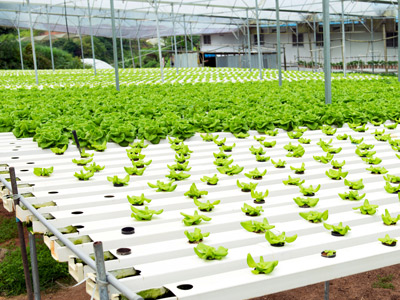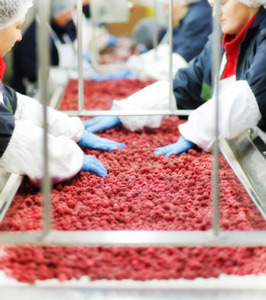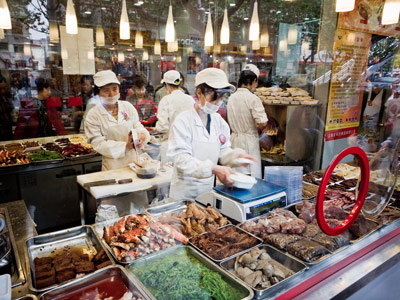Food safety is something we tend to take for granted. When we scan well-stocked supermarket shelves to select food and beverages for our weekly shop, most of us trust – and expect – that the contents of the packets of foodstuffs on display will match the information on the labels. The provenance of the food is something we rarely question, but is everything we eat and drink really what we think it is?
The consequences of food fraud are estimated to cost legitimate food retailers up to USD 15 billion a year.
The horsemeat scandal shattered consumer confidence in the food industry. It turned the spotlight on the whole issue of food safety and food crime, exposing potential fault lines in increasingly complex food industry supply chains, which offer huge potential to criminals to pursue their misdeeds.
This was a Europe-wide issue, with meat products, from ready meals to beef burgers, found to have been contaminated with horsemeat and pork. The scandal erupted after tests were carried out by the Irish Food Authority on a range of meat products sold in major supermarkets. Prior to that, no such tests had been carried out as no one had expected horsemeat, or pork, to be found in beef products.
In the UK, for example, an independent review into the food system in the wake of the horsemeat scandal called for an urgent overhaul of how the food system was policed. The recommendations in the report eventually led to the establishment of the National Food Crime Unit, which works with not only police forces across the UK but also with Europol and the Food Fraud Network that links food safety authorities across Europe.
Fighting the food fraud

Food fraud has been around for a long time and the sums involved are huge. According to the Grocery Manufacturers Association, the consequences of such fraud are estimated to cost legitimate food retailers up to USD 15 billion a year. Dressing up food ingredients is common practice worldwide. But the scale of the fraud could make us choke. In Italy, for example, inferior olive oil has allegedly been passed off as superior extra-virgin olive oil; in the United States, the Food and Drug Administration has warned consumers that cheese labelled as “100 % Parmesan” could be bulked with cheaper substitutes, such as inferior cheese or even wood pulp. And that fish supper you enjoy so much may have been injected with saltwater.
The doctoring of inferior ingredients is one thing, but food fraud has a much darker side. In the early 1980s, hundreds of people died from contaminated cooking oil in Spain and, more recently, in China the industrial chemical “melamine” was found in powdered baby milk, leading to fatalities and thousands of infants falling ill.
Over the past decades, food supply chains have grown increasingly complex and many of today’s food products repeatedly cross national boundaries, creating more opportunities for criminals to practise food fraud. Consider this. According to an article in the Financial Times, an average cod can travel 10 000 miles before it ends up on a dinner plate. It may be caught in the Bering Sea, then prepared and frozen in a factory in eastern China, taken by cargo ship for processing in Europe or the US, and undergo one final journey before ending up as, say, a fish finger on a plate in Moscow. The farm-to-fork journey has involved a lot of hands, with a lot of opportunity for criminals to step in and exploit weak links in the chain.
Along with a growing global population – and as the world becomes ever more complex and interconnected – there is a clear, urgent and compelling need to standardize regulations on an international level. Food fraud has become more sophisticated and harder to detect, presenting regulators with an even bigger challenge. In the wake of the horsemeat scandal, for instance, authorities were left scrambling in their efforts to organize a coordinated approach to deal with the crime. Indeed, so far there have been only a few prosecutions – encouraging news for criminals.
Best in class

The scale of the challenge is huge. Large supermarkets stock thousands of different food products, and smaller food businesses do not have the resources to “police” their supply chains. With a growing pressure to produce affordable food, there is increasing temptation to cut corners on health, safety and quality controls, which in turn puts more pressure on governments and food regulators. So what lessons have been learned since 2013 and what can be done to restore trust?
ISOfocus asked industry experts for their perspectives on these issues and what needs to be done to regain consumer confidence and ensure that the food we are buying is healthy and nutritious – and how the ISO 22000 family of standards can help.
Certification bodies play a critical role in efforts to improve the safety of food systems. Food certification promises higher standards and transparency, but is it an effective weapon in tackling food fraud? The FSSC 220001) Food Safety Management System (FSMS) certification scheme helps companies to produce safe food and gain the trust of customers. The system was designed to provide companies in the food industry with an ISO standard-based FSMS certification that is recognized by the Global Food Safety Initiative and includes auditing by certification bodies accredited to ISO/TS 22003, which encompasses requirements of ISO/IEC 17021.
Aldin Hilbrands, FSSC 22000’s Technical Director, says: “We support food companies with best-in-class rules and regulations, laid down in the global FSSC 22000 certification scheme, to produce safe food and gain the trust of their clients.”
He asserts that better public-private collaboration would go a long way to restoring trust and ensuring quality and brand integrity. Public authorities and the private sector both want to protect consumer health, “but in many countries these parties do not yet work closely enough to advance food safety in a more efficient and effective manner”.
With governments and food regulators coming under increasing pressure to maintain health and safety standards, it is encouraging to note that the FSSC 22000 is increasingly being contacted by governments in North America and Europe to explore smarter ways of aligning efforts on this issue, Hilbrands says. Furthermore, he adds, “unannounced audit elements are planned to be included in the certification cycle of the scheme soon”, which will also help to ensure product integrity.
Gaps in the system

The National Registry of Food Safety Professionals (NRFSP) is another US certification body that is accredited to develop and provide food manager certification examinations. The big challenge, says Lawrence Lynch, President of the NRFSP, “is how, as a certification body, we play a role in supporting a food safety culture rather than simply providing an examination”. Lynch recognizes the scale of the problem to find “common ground in the world of food” and says there are “plenty of gaps in this food system”. He acknowledges that the certification by itself would probably never prevent, say, the likes of the horsemeat scandal but that, when administered as part of a larger food safety management system, those who have the certificate “should be in a better position to identify inherent weaknesses in the chain and communicate concerns before they become a scandal”.
According to Lynch, what gives the NRFSP extra clout is that it applied for, and was eventually granted, accreditation under ISO/IEC 17024 for its food manager exam programme. “While adoption of the ISO/IEC 17024 accredited certification of persons by retailers has been slow, the National Registry has been able to start a conversation about the value of certified persons by accreditation to ISO/IEC 17024 on a national stage,” he says.
Coaching consumers

Of course, any conversation on food safety and food fraud has to include the consumer. The role that consumers play is a big issue for Consumers International, the world federation of consumer groups. ISO 22000 helps manufacturers ensure food safety and uses traceability to guarantee the origin of food ingredients. However, consumers bear some responsibility for safety after purchase if they fail to handle food properly by allowing cross-contamination and poor hygienic practices and ignoring advice from manufacturers.
Sadie Homer, Senior Policy Advisor on Standards, Consumers International, and food quality expert Philip Creed, a Consumer Representative on BSI/CEN/ISO food standards committees, believed this responsibility should not be left entirely to state regulatory bodies; better consumer education and knowledge are key. “One challenge for many consumers is understanding the basics of handling food safely at home – how to store it appropriately, how to avoid cross-contamination, how to cook food or reheat prepared foods properly and how to dispose of waste food safely.”
They go on to say that the ISO 22000 food safety management system “helps by ensuring that the food on sale in supermarkets has been produced in ways which minimize the risk of microbial infection and contamination entering the consumer’s kitchen”.
According to Homer and Creed, ISO 22000 has made a significant contribution to tackling food fraud. “Since its introduction in 2005, the standard has been taken up by many thousands of food manufacturers worldwide and formed the basis of many tailored food safety management programmes, thus providing consumers with more assurance that the food they buy has been manufactured safely from traceable ingredients.”
To harm or not to harm?

The ISO 22000 family of standards that focus on different aspects of food safety management is clearly an effective tool in tackling a very complex subject. Albert F. Chambers, President of Monachus Consulting, a management service company specializing in agrifood industries, has been involved with the development of the ISO 22000 standards since September 2003 and has contributed as an expert and national delegation leader to the development of ISO 22000, ISO/TS 22003, ISO 22004 and ISO 22005. For him, it all comes down to trust. “Whether you are looking at food from the local or the global perspective, the food business operates on a very high level of trust. Food safety management system standards, such as ISO 22000, are voluntary tools that food businesses are using to enhance that level of trust,” he says.
Chambers draws the distinction between “intentional adulteration or misrepresentation of foods or food ingredients for economic gain” and “intentional contamination or adulteration where there is an intent to cause public health harm and/or economic disruption”. He says there are well-recognized approaches that a food business can take to deal with the latter – usually called “food defence” measures – and they are accepted as prerequisite programmes within the ISO 22002 series of technical specifications. While the working group of experts revising ISO 22000 have still to incorporate the measures a food business can take to fight food fraud, he says that existing provisions of the standard define some very workable processes: “knowing your suppliers, setting clear specifications, requesting reputable certificates of analysis, etc.”
Producing good-quality, nutritious and affordable food in a world of 7.4 billion people is always going to be a huge challenge. Surprisingly enough, Chambers claims the biggest threat to food safety doesn’t come from the criminal fraternity but from unintentional contamination. “This can happen when food businesses don’t have good systems in place to prevent biological, physical or chemical contamination and when they don’t implement those systems consistently,” he says.
Quelling food fears

So is the farm-to-fork journey any safer? Despite the lack of prosecutions related to the horsemeat scandal, it did teach all stakeholders in the food industry some valuable lessons. Food crime is now a known risk to companies. Authorities across the EU, for instance, are working more closely on food fraud, and there is a bigger push to educate the consumer on food hygiene and improve food labelling. All of these, plus certification for the industry and International Standards can help to mitigate risks.
No doubt there will be more scandals of the horsemeat variety in the future. However, Chambers believes that the ISO 22000 standards should make us all feel more reassured about our weekend supermarket shop.
“ISO 22000 is a world-class standard,” he says. “If properly used, and fully implemented, it provides the toolkit that a food business at any point along the food chain needs to produce safe food. It incorporates the best in management practices and the latest in food safety systems design, with very strong provisions for internal and external communication as well as an intense focus on both the competence of personnel and the improvement of the system over time.” Food for thought indeed.
1) Created in response to the needs of the international food sector, the Food Safety System Certification 22000 (FSSC 22000) provides an independent ISO-based food safety management scheme for third-party auditing and certification. FSSC 22000 is fully recognized by the Global Food Safety Initiative, an industry-driven global collaborative platform to advance food safety.

